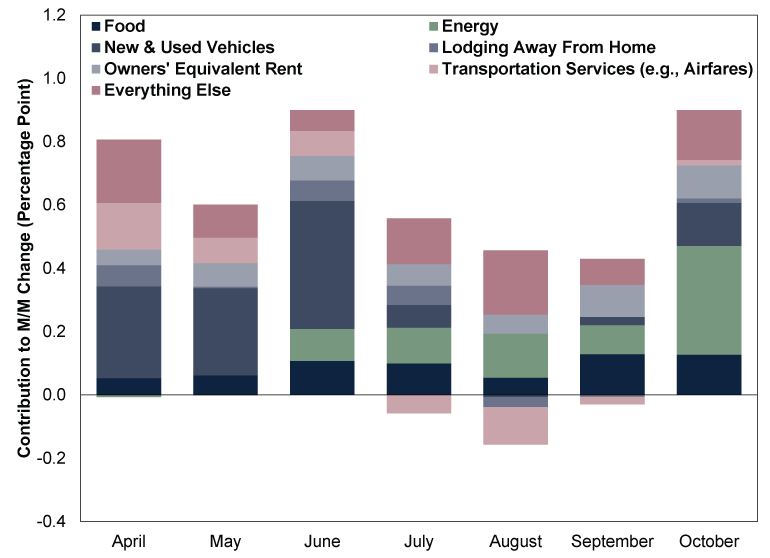Personal Wealth Management / Economics
‘Too Few Goods’—the Simple Explanation for October’s Elevated US Inflation Rates
Shortages cause prices to rise, but they likely won’t last forever.
The US Consumer Price Index (CPI) inflation rate hit a 30-year high, 6.2% y/y, in October.[i] Many financial commentators we follow argue this is a big warning sign for the UK and Europe, implying dogged, persistent inflation will take hold on both sides of the Atlantic Ocean. Whilst we agree inflation rates are likely to remain elevated in the short term, we still think it is premature to say high inflation will last indefinitely. In our view, America’s high inflation rate is a symptom of a reality we have all lived through the past 20 months: It is far, far easier for a government to suddenly stop economic activity via lockdown than for businesses to restart it once regulations permit. We think stocks have long understood this, even if it is only just starting to dawn on the world at large.
We do think it is useful to look to the US as a preview for the UK and Europe, given America reopened from lockdowns sooner, making several US economic indicators’ recovery run a few months ahead of those in the UK and Europe.[ii] And in America, the sudden halt and choppy restart of the global economy explains much of consumer prices’ trajectory since early 2020, in our view. First lockdowns shattered production and demand, sending prices tumbling.[iii] That created a low year-over-year comparison point this spring, when vaccines’ rollout enabled broader reopening, juicing consumer demand. We think that added skew to the year-over-year inflation rate, making the month-over-month rate a better place to look when assessing inflation’s drivers. As Exhibit 1 shows, the biggest contributors to month-over-month rates this spring and summer were categories tied most to reopening, including hotels, airlines and used cars—which were in short supply after rental car companies rebuilt their fleets in a hurry.
But as summer rolled into autumn, some reopening-related pressures faded, as Exhibit 1 also demonstrates, and new pressures appeared in their wake. Many stemmed from supply shortages, which in turn stemmed from labour shortages and global shipping delays. These are perhaps most visible in accelerating food and vehicle prices. Owners’ equivalent rent is another recent driver—an imaginary cost that no one pays, as it is the hypothetical amount a homeowner would pay to rent their own house. The other recent big contributor is energy prices—namely oil and petrol prices—which jumped when global demand surged as coal and natural gas prices spiked and utilities throughout Europe and Asia needed an alternate power source in a hurry.[iv] In October, energy alone accounted for over one-third of CPI’s 0.9% m/m rise.[v]
Exhibit 1: Inflation Pressures’ Shift From Reopening to Shortages

Source: US Bureau of Labor Statistics, as of 10/11/2021.
As Nobel laureate Milton Friedman taught, inflation is always and everywhere a monetary phenomenon—too much money chasing too few goods. When assessing inflation, we find it helpful to break that last clause into its three parts: too much money, chasing and too few goods. M2 money supply surged last year as the Fed pumped out liquidity to replace businesses’ lost sales and households’ lost paychecks.[vi] But bank reserves account for nearly half of the cumulative increase since 2020 began, and the vast majority seem to be excess reserves sitting on deposit at Federal Reserve banks and not backing loans.[vii] Excluding bank reserves, M2 money supply is now growing more slowly than it did for most of 2015 – 2019, when inflation was mostly below the Fed’s 2% y/y target, much to policymakers’ chagrin.[viii] Weak lending also suggests money isn’t doing much “chasing,” a notion underscored by the historically low velocity of money, which is a measure of how quickly each dollar in circulation changes hands.[ix] US personal consumption expenditures—the broadest measure of household spending—have already slowed from a reopening resurgence to rates more akin to the pre-pandemic norm, and surveys show many households used stimulus money to repay debt or build savings they may not spend at all.[x] In our view, it doesn’t look like there is a mountain of household liquidity waiting to do more chasing from here.
That leaves the “too few goods” part of Friedman’s statement to assess. As commentators and analysts globally have documented, supply is quite short across a range of goods. We think this is a testament to the impossibility of managing the economy from the top down. Governments can easily put the economy into a medically induced coma at the drop of a hat. Shutting down is all too easy. But restarting is another matter, especially outside the laptop work-from-home world. When American businesses were forced to shut or operate at minimum capacity for months, many had to cut overhead costs to survive, especially since it was impossible to know how long lockdowns would last and whether they would return once over. For many businesses, this meant furloughing or laying off workers, shutting facilities and running down inventories. Commentators have reported this occurring all up and down the supply chain. You can’t undo that overnight.
Rebuilding a staff takes time and money. So does increasing production to meet resurgent demand. A farmer who beefs up their cattle herds[xi] today in response to high meat prices won’t be able to meaningfully increase beef supply for a year at least, depending on the age and breed of cow. A wholesaler who sold off a warehouse to make ends meet last year can’t immediately get that space back. Similarly, it can take months for new oil well drilling to translate to new petrol flowing out of refineries. Extrapolate these headaches across the entire universe of physical goods and energy commodities, and you end up with a choppy recovery in output that trails the recovery in demand. In other words, exactly what data and anecdotal reports show the world has endured in recent months.
Encouragingly, we see strong indications that this situation will even out sooner than later, particularly on the energy side. We have written before on spiking energy prices’ myriad causes and won’t rehash that here, but the effects appear to be waning. Benchmark European natural gas prices are down -40.6% from October’s peak.[xii] European wind power generation is up.[xiii] Chinese thermal coal prices are down -52.7% and back at pre-spike norms.[xiv] Combined, we think these developments should help reduce the demand for oil as it helps abate power providers’ need for an emergency electricity source. Meanwhile, US oil rig count is up from 172 in mid-August 2020 to 450 as of last Friday, and domestic production rose to 11.5 million barrels per day last week, matching its year-to-date high.[xv] We think US oil production will likely rise further as more rigs come online. American crude oil inventories have also risen in recent weeks.[xvi] As a result, the US Energy Information Administration projects global oil prices will peak this month as supply and worldwide demand come back into balance, then drift lower over the foreseeable future.[xvii] Whilst the EIA’s forecast could be wrong, it seems to be rooted in a sound look at fundamentals, in our view.
Rising supply doesn’t mean consumer prices will fall. But we think it likely does mean that the big month-over-month increases should soon become a thing of the past, with prices growing more slowly off a higher base—an eventuality that we also think is likely in the UK and Europe. That isn’t pleasant for households trying to make ends meet, but our research shows it is the normal course of things when price increases work their way through the economy. The mechanics of this are as old as economics itself and therefore not at all a surprise to stocks, which our research shows are excellent at discounting economic trends and likely know how the plumbing works by now.
[i] Source: US Bureau of Labor Statistics, as of 10/11/2021. CPI is a government-produced measure of prices in goods and services across the broad economy.
[ii] Source: FactSet, as of 10/11/2021. Statement refers to gross domestic product (GDP, a government-produced measure of economic output), retail sales and industrial production in the US, UK, Germany, France, Italy and Spain.
[iii] Ibid. Statement based on US CPI.
[iv] Ibid. Statement based on Dutch TTF Gas Prices, Chinese Thermal Coal Prices and Brent Crude Oil Prices.
[v] See Note i.
[vi] Source: St. Louis Federal Reserve, as of 10/11/2021. M2, a measure of broad money supply includes all coins and notes in circulation, bank reserves, deposits and money market funds held outside of tax-deferred retirement accounts.
[vii] Ibid. Statement based on M2 money supply and total reserve balances. The Federal Reserve ceased publishing its measure of excess reserves in September 2020. But until then, excess and total reserves were moving in tandem. Considering lending hasn’t soared since then, according to the Federal Reserve’s measure of loans and leases in bank credit, we consider this statement about excess reserves’ dominance to be a fair deduction.
[viii] Ibid.
[ix] Source: Federal Reserve Bank of St. Louis, as of 10/11/2021. Statement based on the velocity of M2 money supply.
[x] Source: FactSet, as of 10/11/2021. Statement based on US Personal Consumption Expenditures. “Study Shows Surge in Savings During Pandemic,” Rick Babson, Kansas City Federal Reserve, 29/4/2021.
[xi] Pun intended.
[xii] Source: FactSet, as of 10/112021. Dutch TTF Gas Price in EUR, 6/10/2021 – 10/11/2021.
[xiii] Source: WindEurope, as of 10/11/2021.
[xiv] Ibid. China Thermal Coal Price in CNY, 20/10/2021 – 10/11/2021.
[xv] Source: FactSet and US Energy Information Administration, as of 10/11/2021.
[xvi] “This Week in Petroleum,” US Energy Information Administration, 10/11/2021.
[xvii] Ibid.
Get a weekly roundup of our market insights.
Sign up for our weekly e-mail newsletter.

See Our Investment Guides
The world of investing can seem like a giant maze. Fisher Investments UK has developed several informational and educational guides tackling a variety of investing topics.




